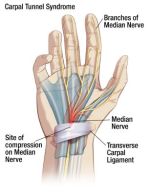- Home
- CTS treatments
- Carpal Tunnel Splints
Carpal tunnel Splints
There are many different types of carpal tunnel splints and braces out on the market today for treating carpal tunnel syndrome (CTS). Some are for work and some are for play (or sports). Really, I think there are too many! BUT every carpal tunnel splint manufacturer tries to point out why theirs are the best.
Also for clarification purposes, carpal tunnel wrist splints are basically the same thing as carpal tunnel wrist braces.
Also for clarification purposes, carpal tunnel wrist splints are basically the same thing as carpal tunnel wrist braces.
See Carpal tunnel brace Store
See Cutting-Edge Wrist Braces
Overall, there are 2 major types or differences that you need to keep in mind when talking about a WRIST SPLINT or (wrist brace) and a WRIST SUPPORT or (wrist wrap).
Unfortunatley, the industry as a whole as well as the medical profession, interchanges these words a lot of times. (Even on this website
carpal-tunnel-symptoms.com, I try to give you all the other names something may be called, for your own clarification).
The wrist splint (brace)
The first type we will talk about are the carpal tunnel splints or (wrist braces) and as the name implies it should have some type of splint, brace or stay in it, and for the most part this is usually a flat thin piece of metal or stiff plastic. This should make the wrist joint immobile (i.e. can't bend it)
The metal or plastic stay should have an upward curve that fits comfortably in the palm.The purpose is to "cock-up" the wrist or hold the wrist in a slightly bent backwards position (about 30 degrees). This is actually the resting or neutral position for the wrist. This position is the natural resting posture for the wrist.
The carpal tunnel
Night Splint or (nocturnal splints ) also fall under this category. Again, the purpose is to keep the wrist in that natural position so that you don't bend and crimp the median nerve as you sleep.
See
non-surgical treatments
Depending on your job or around the house tasks, you may be on some type of WORK RESTRICTIONS, or limited duty. The metal stay in the palm makes it difficult to grip power tools but other tasks such as typing may not be affected that much. Talk with your employer if you think you need some kind of work restrictions for your carpal tunnel syndrome.
Carpal tunnel splints can also be used for
Acute Wrist injuries, such as wrist sprains and dislocations. Fractures are usually put in a cast at first, but after the cast comes off, sometimes a wrist splint is used for support until you can wean yourself off of it completely as your wrist heals.
Also after,
carpal tunnel surgery sometimes a carpal tunnel wrist splint is recommended, but again, it just depends on your expected hand and wrist activity during the healing phase.
The wrist support (wrap)
The second type of wrist product is called a
wrist support or wrist wrap, and really the main difference is that these don't have a rigid stay or brace in them. They can still be quite stiff and some offer more support than others. In general, if it is a sport or work type of wrist support it typically doesn't have a rigid stay in it,Therefore, you have more wrist movement or mobility.
These type of wrist supports would be recommended for someone who wants to remain active but still have some support or have a reminder that your wrist is not 100%. Since this type of wrist support doesn't have the metal stay in the palm, it allows you to grip things (i.e. power tools etc..) more normally, than with a carpal tunnel wrist splint.
Good carpal tunnel splints and wrist supports should have a thumb loop. This prevents the the splint or support from sliding down your wrist (around where you wear your watch). If it does this, it's not giving your wrist joint any support. It's just like a band or collar around your wrist and can have a
TORNIQUET EFFECT on your carpal tunnel.
I never ever recommend the band-like wrist supports for this reason! Also I never recommend the tight elastic pull-over type of wrist products, they offer no real support, and are very constricting, which usually causes swelling in the fingers.
Remember, carpal tunnel wrist splints can help relieve your CTS symptoms if you select the right product and if used prorperly along with other non-surgical treatment options.
Carpal Tunnel Syndrome causes
Anatomy of the carpal tunnel
CTS Explanation
Latest diagnostic criteria for CTS
- Home
- CTS treatments
- Carpal Tunnel Splints
Share this page:
Recent Articles
-
The carpal tunnel store
The carpal tunnel store has a huge selection of Medical Grade Products -
Anatomy of the carpal tunnel
The carpal tunnel anatomy is easy to understand if you remember we're dealing with a tunnel of sorts in your wrist. Learn the anatomy from a medical practitioner. -
Carpal tunnel prevention program
A carpal tunnel prevention program at the workplace may help employees from getting symptoms. Learn the best carpal tunnel prevention program on the web today.
Recent Articles
-
The carpal tunnel store
The carpal tunnel store has a huge selection of Medical Grade Products -
Anatomy of the carpal tunnel
The carpal tunnel anatomy is easy to understand if you remember we're dealing with a tunnel of sorts in your wrist. Learn the anatomy from a medical practitioner. -
Carpal tunnel prevention program
A carpal tunnel prevention program at the workplace may help employees from getting symptoms. Learn the best carpal tunnel prevention program on the web today.
